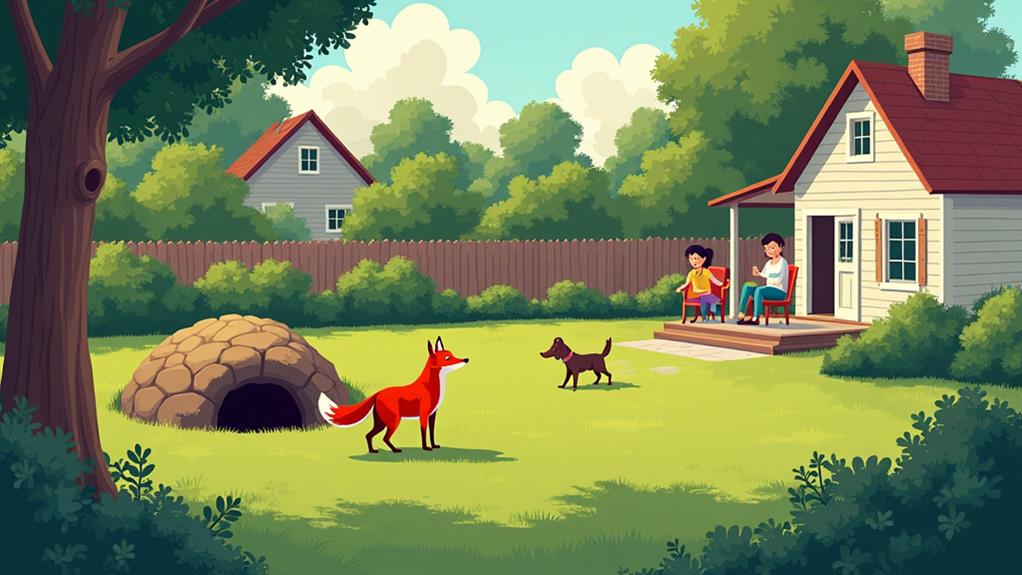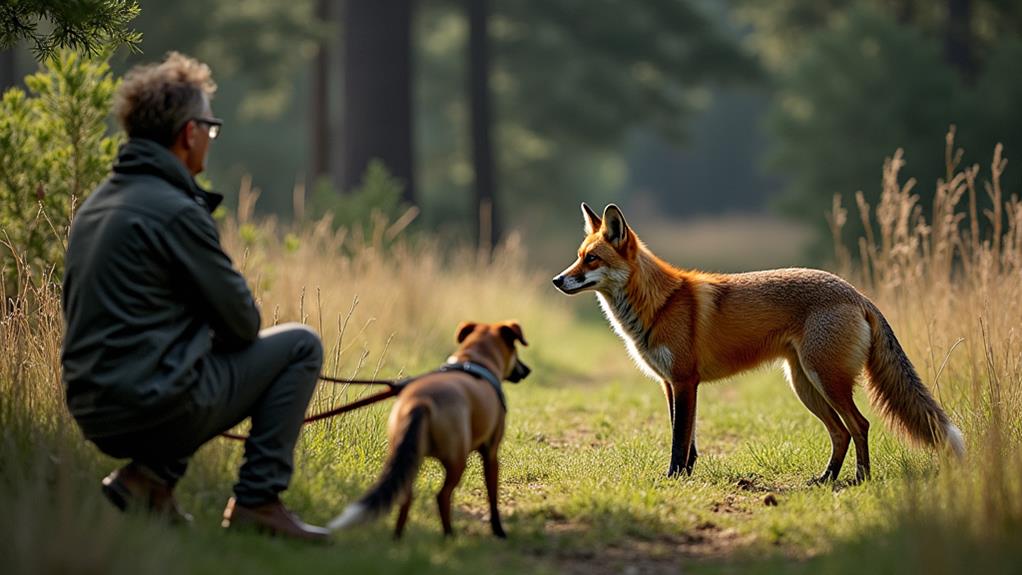To keep your dogs safe from those sly red foxes, it's important to understand their sneaky ways! These nocturnal critters might view small dogs as easy snacks, especially during evening hours. So, it's wise to supervise your tiny pals and keep them indoors at dawn and dusk. If you spot fox tracks or hear odd vocalizations, know that they're nearby. A solid fence can deter them, but consider extra measures like buried hardware cloth. And don't forget—keeping your pets' vaccinations up-to-date can shield them from disease risks. There's a lot more to know about fox behavior and safety tips ahead!
Contents
Overview of Red Fox Behavior

When you think about red foxes, it's important to understand their behavior, especially since it can impact the safety of your dogs.
These clever creatures tend to be mostly nocturnal, making their appearances more common during the early mornings or late evenings. In urban areas, where food sources are plenty, foxes often venture closer to humans, which can make them bolder than their wild counterparts. Their adaptability to diverse environments illustrates their opportunistic nature, enabling them to thrive even in mixed landscapes.
Typically shy, foxes prefer to avoid confrontations. But if they ever feel threatened, they can display some defensive behaviors that might surprise you. Instead of running away, they may stand their ground!
Their vocalizations, like barks and howls, might sound alarming, but they're usually just chatting among themselves, not calling for trouble.
Assessing Risks to Domestic Pets
Evaluating the risks foxes pose to domestic pets is essential for any pet owner. While adult cats are usually safe from these sly creatures, small dogs under 15 pounds can be at higher risk due to their size and vulnerability.
Red foxes, which are adaptable and thrive in urban environments, could easily see them as easy prey, especially during those evening escapades when foxes are most active. They often navigate neighborhoods to scavenge for food, and their versatile behavior can lead them closer to residential areas than one might expect red foxes thrive in urban environments.
It's important to remember that fox attacks on cats are quite rare, with only 0.14% of cats affected according to a 2013 UK study. Larger dogs over 50 pounds tend to scare off foxes, who prefer to flee rather than confront them. So, if you've got a fluffy giant, they're likely your home's protector!
For small pets, keeping a close eye on them is key. Supervision and secure enclosures are fantastic ways to mitigate any potential risks. A little preparation goes a long way in keeping your furry friends safe.
You can always enjoy the outdoors together; just make sure your small pet's adventures are safe ones—after all, no one wants to share their backyard with a sly fox!
Signs of Fox Presence in Neighborhoods

Have you ever spotted unusual tracks in your yard and wondered what made them? Those little paw prints could mean a fox is hanging around, especially if you hear their playful yips at night.
Red foxes are known for their adaptability, often making urban environments their home due to the abundance of resources such as food scraps and safe nesting spots in gardens, making sightings more common.
Plus, when you find remnants of their meals—or perhaps some odd digging under your shed—it's a clear sign they're using your neighborhood for a bit of fox-style fun diverse habitats they thrive in.
Tracks and Scat Identification
Identifying the tracks and scat of red foxes can be essential for pet owners concerned about their dogs' safety. If you spot fox tracks in your neighborhood, you're looking at prints about 2 to 3 inches long. They've a unique shape with elongated toes, often resembling a smaller dog's paw. If you notice a stride length of about 12 to 15 inches between the prints, that's a clear sign of a fox nearby.
Now, let's not forget about fox scat. This tubular droppings, roughly 1 inch in diameter, reveal quite a bit about their diet, which might include fur, bones, or even fruit. Its color can range from dark brown to light gray, depending on what they've been munching on.
Be careful, though—it can have a strong odor that's hard to miss!
Pay attention to clusters of tracks or scat, especially near dens or areas where prey is abundant. These signs indicate that red foxes are visiting frequently, which should alert you to potential risks for your dog.
Keeping an eye out can help you make informed choices for your furry friends, ensuring they stay safe.
Vocalizations and Nocturnal Activity
At night, the eerie sounds of fox vocalizations—barks, screams, and howls—can echo through neighborhoods, signaling their presence. If you've ever been startled by these sounds, you're not alone! Urban foxes are mainly nocturnal, and their vocalizations often serve as a form of communication. They chat with each other to establish territory and can give hints about their breeding season, especially loud in late winter and early spring.
You might also notice urban foxes during the day, particularly when they're out foraging for food. This daytime activity increases the chance of your furry friends crossing paths with these clever critters. As the weather warms up, you may hear more fox sounds, especially when they're raising their young.
Keeping an ear out for those distinctive vocalizations is one of the best ways to gauge if foxes are nearby. So, if you hear a commotion at night or spot a furry friend outside, it's a sign to keep a close watch on your pets!
After all, understanding these vocalizations helps you create a safer environment for everyone involved.
Food Sources and Evidence
Foxes are clever scavengers, often drawn to neighborhoods by accessible food sources like pet food left outside or overflowing garbage bins.
To keep your dogs safe, it's important to understand what attracts these crafty critters. If you notice digging near your trash or compost bins, it's a sign that foxes are exploring for food scraps.
Look out for their tracks in soft soil or sandy areas; these paw prints can reveal their movement patterns. You might also stumble upon their scat, which often contains remnants of their diet, like fur, bones, or fruit seeds—useful clues to identify their activity nearby.
Sometimes, foxes attack small animals, and that can cause a stir, so pay attention if you hear loud noises or see birds squawking. This commotion often indicates foxes are hunting or scavenging nearby.
Neighborhoods with dense vegetation or parks are ideal habitats for these sly little hunters, increasing the likelihood of spotting them.
Safety Precautions for Dog Owners
As a dog owner, you need to take specific safety precautions to protect your furry friend from potential fox encounters. Small dogs, especially those under 15 pounds, are at a higher risk of fox attacking.
So, keep a close eye on them when they're outside, particularly in areas where foxes might roam.
Even if you have a fenced yard, remember that it mightn't be foolproof. Consider burying hardware cloth around the base of your fence to add an extra layer of protection.
Also, keep your little one indoors during dawn and dusk, when foxes are most active. Trust me; it's not worth the risk!
Avoid leaving your small dog unattended outside. It's like inviting trouble—don't do it!
Instead, learn about fox behavior and use humane deterrents. Loud noises or motion-activated lights can help keep those pesky critters at bay.
Managing Fox Dens Near Homes

When you discover a fox den near your home, it's important to handle the situation with care. A fox family may be setting up shop under your porch or shed, and those playful kits usually emerge about 4 to 5 weeks after they're born.
So, it might be wise to let them be for a while! Disturbing the den can make the foxes more bold, which isn't the best outcome for anyone, especially small pets.
To encourage the foxes to keep their distance, try using some humane deterrents. Loud noises, a few stinky items, or shiny objects placed around the den site can work wonders!
If you want to secure the area long-term, consider burying hardware cloth to prevent them from returning next season.
During this time, keep a close watch on the area. It's a good idea to keep your small pets indoors, especially when the kits are making their first appearances.
This way, you'll protect your furry friends while allowing the fox family to thrive in nature. It's all about harmony, right? After all, we all just want to live peacefully alongside our wild neighbors!
Understanding Fox Disease Risks
When you think about foxes, you might picture cute, bushy-tailed critters, but they can carry some serious health risks.
Rabies symptoms like aggression or even unusual tameness can make them a danger to both pets and us, while pesky mange can lead to more aggressive behavior that affects your dog.
Rabies Symptoms in Foxes
Rabies symptoms in foxes can pose significant risks to both wildlife and domestic pets. When a fox gets rabies, you might see signs like staggering, paralysis, or even unexpected aggression. This might sound alarming, but knowing what to look for can help keep your furry friends safe.
Infected foxes often lose their natural fear of humans and other animals, making them seem almost friendly. Don't let this unusual tameness fool you!
The incubation period for rabies is 21 to 80 days, so the virus can be sneaky before symptoms show. While rabies transmission from foxes to humans is very rare in the U.S.—no deaths reported from 2009 to 2018—it's still essential to be cautious.
If you've got pets, especially playful dogs who love to chase or even attack cats, ensuring their vaccinations are up to date is important. Keeping your pets protected is the best way to keep them safe, as they can get exposed to rabid wildlife.
Mange Effects on Health
Mange, a disease caused by Sarcoptes scabiei mites, can have serious effects on the health of foxes and influence their behavior towards humans and pets. When foxes are affected, they experience severe itching, hair loss, and skin irritation. These symptoms can make them look pretty sad and cause distress.
Unfortunately, the discomfort might lead some foxes to act out, exhibiting rabies-like behaviors. You see, the stress of scratching can trigger unusual and unpredictable actions.
When foxes struggle with mange, they may become less fearful of humans and even pets. That's where things can get tricky! If you spot a fox that looks sick, it's best to keep a healthy distance. While rabies is rare, it's always smart to keep an eye on your dogs and cats for any suspicious behaviors, especially around challenging fox situations.
If you think a fox needs medical attention, don't try to help it yourself. Instead, contact local wildlife authorities who can assist.
Responding to Fox Encounters

Encountering a fox can be a surprising experience, but knowing how to respond can keep you and your pets safe. If you spot a fox, don't panic! You can make loud noises or wave your arms to scare it away since most foxes prefer to flee from perceived threats.
Remember to maintain a safe distance; approaching or trying to touch the fox can provoke a defensive attack.
While observing the fox, keep an eye out for any unusual behavior, like staggering or excessive tameness. These signs might indicate illness, such as rabies, and it's best to report those encounters to local animal control to guarantee everyone's safety.
When walking in areas known for fox activity, always keep your pets on a leash. This helps prevent any potential conflict and protects your furry friends.
If you find a fox denning in your yard, it's best to leave it alone. Instead, consider humane deterrents to encourage the fox to relocate peacefully.
In understanding how to respond to fox encounters, you not only keep yourself safe but also play a part in coexisting with these clever critters. Your awareness truly makes a difference!
Wildlife Conservation and Community Efforts
Understanding how to coexist with foxes also opens the door to broader wildlife conservation efforts in your community. When you take steps to protect wildlife, you're helping create a healthier environment for everyone, including your pets.
By fostering humane backyards that support local ecosystems, you can do your part to minimize conflicts with our furry friends, like the red fox.
Engaging your neighbors in wildlife protection is vital. When everyone pitches in, you raise awareness about preserving habitats, reducing the odds of foxes venturing into urban areas—nobody wants to hear horror stories about pets getting attacked by a fox.
Educational programs can help folks learn about responsible waste management, keeping tempting snacks out of sight and giving critters less reason to visit.
Consider donating to wildlife organizations—every little bit helps fund important habitat restoration projects.
And don't forget to collaborate with local governments to guarantee sustainable urban planning! This way, we can all enjoy our yards without feeling like we're living in a wildlife showdown.
Final Thoughts
In the wild world of red foxes, staying savvy about their sneaky ways can save your sweet pup from potential problems. Keep your eyes peeled for signs of foxes, and don't forget to employ some safety strategies. By blending caution with community care, we can create a safer space for our furry friends. So, let's team up for a tail-wagging triumph, ensuring our dogs stay safe while living harmoniously with nature's crafty canines!














